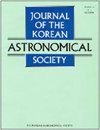A NEW HARDWARE CORRELATOR IN KOREA: PERFORMANCE EVALUATION USING KVN OBSERVATIONS
IF 0.8
4区 物理与天体物理
Q3 ASTRONOMY & ASTROPHYSICS
引用次数: 26
Abstract
We report results of the performance evaluation of a new hardware correlator in Korea, the Daejeon correlator, developed by the Korea Astronomy and Space Science Institute (KASI) and the National Astronomical Observatory of Japan (NAOJ). We conduct Very Long Baseline Interferometry (VLBI) observations at 22 GHz with the Korean VLBI Network (KVN) in Korea and the VLBI Exploration of Radio Astrometry (VERA) in Japan, and correlated the aquired data with the Daejeon correlator. For evaluating the performance of the new hardware correlator, we compare the correlation outputs from the Daejeon correlator for KVN observations with those from a software correlator, the Distributed FX (DiFX). We investigate the correlated flux densities and brightness distributions of extragalactic compact radio sources. The comparison of the two correlator outputs shows that they are consistent with each other within < 8%, which is comparable with the amplitude calibration uncertainties of KVN observations at 22 GHz. We also find that the 8% difference in flux density is caused mainly by (a) the difference in the way of fringe phase tracking between the DiFX software correlator and the Daejeon hardware correlator, and (b) an unusual pattern (a double-layer pattern) of the amplitude correlation output from the Daejeon correlator. The visibility amplitude loss by the double-layer pattern is as small as 3%. We conclude that the new hardware correlator produces reasonable correlation outputs for continuum observations, which are consistent with the outputs from the DiFX software correlator.韩国一种新的硬件相关器:使用KVN观察进行性能评估
我们报告了由韩国天文和空间科学研究所(KASI)和日本国家天文台(NAOJ)开发的韩国新型硬件相关器大田相关器的性能评估结果。利用韩国的VLBI网络(KVN)和日本的VLBI射电天文探测(VERA)在22 GHz波段进行了甚长基线干涉测量(VLBI)观测,并与大田相关器进行了相关。为了评估新硬件相关器的性能,我们比较了大田相关器对KVN观测的相关输出与软件相关器分布式FX (DiFX)的相关输出。我们研究了河外致密射电源的相关通量密度和亮度分布。两个相关器输出结果的比较表明,它们的一致性在< 8%以内,这与22 GHz KVN观测值的幅度校准不确定度相当。我们还发现,8%的磁通密度差异主要是由(a) DiFX软件相关器和大田硬件相关器的条纹相位跟踪方式的差异,以及(b)大田相关器的振幅相关输出的异常模式(双层模式)引起的。双层模式的能见度振幅损失仅为3%。我们得出结论,新的硬件相关器对连续观测产生合理的相关输出,这与DiFX软件相关器的输出一致。
本文章由计算机程序翻译,如有差异,请以英文原文为准。
求助全文
约1分钟内获得全文
求助全文
来源期刊

Journal of the Korean Astronomical Society
地学天文-天文与天体物理
CiteScore
1.30
自引率
10.00%
发文量
0
审稿时长
>12 weeks
期刊介绍:
JKAS is an international scientific journal publishing papers in all fields of astronomy and astrophysics. All manuscripts are subject to the scrutiny of referees. Manuscripts submitted to JKAS must comply with the ethics policy of JKAS. Six regular issues are published each year on February 28, April 30, June 30, August 31, October 31, and December 31. One year''s issues compose one volume.
 求助内容:
求助内容: 应助结果提醒方式:
应助结果提醒方式:


